The History Of Citroen BX 15
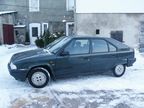
The Citroën BX is a large family car that was produced by the French manufacturer Citroën between 1983 and 1994. In total, 2,315,739 BXs were built during its 12-year history.[citation needed] The hatchback was discontinued in 1993 with the arrival of the Xantia, but the estate continued for another year.
The Citroën BX was launched in Paris 1983 under the Eiffel Tower. The BX was designed to replace the successful small family car Citroën GS with a larger vehicle. The last BX was made in 1995, but its successors had already been launched. It had been partially replaced by the smaller ZX in early 1991, but its key replacement was the slightly larger Xantia that had gone on sale in early 1993.
The angular Gandini-designed hatchback was strongly inspired by the British 1977 Reliant FW11 concept and the 1979 Volvo Tundra concept car (also designed by Bertone). It was one of the first cars to benefit from the merger of Peugeot and Citroën in 1976, sharing its platform with the more conventional 405 that appeared in 1987. Among the features that set the car apart from the competition was the traditional Citroën hydropneumatic self-levelling suspension, extensive use of plastic body panels (hood, tailgate, bumpers), and disc brakes front and rear.
The BX used the XY, TU and XU series of petrol engines in 1.4 L, 1.6 L and 1.9 L displacements (a 1.1 L engine, very unusual in a car of this size, was also available in Italy, Portugal and Greece). The 1.1 and 1.4 unit was an old Peugeot/ Reanult powertrain with its roots in the Peugeot 104 and Renault 14, but the 1.6 and 1.9 was all-new and later used in many Peugeots. The class leading XUD diesel engine version was launched in 1984. The diesel and turbo diesel models were to become the most successful variants, they were especially popular as estates. It was this Peugeot influence that endowed the BX with some much needed reliability, something for which its predecessor, the GS, had a marginal reputation. This led to the BX's famous advertising slogan "Loves Driving, Hates Garages".
All engines were badged as 11, 14, 16, 19 — signifying engine size (In some countries, a weaker, 80Bhp version of the 1.6 L engine was badged as the BX15E instead of BX16). The 11TE model was seen by foreign motoring press as slow and uncomfortable.[citation needed]
The 1.1 L engine with engine code H1A was specially tuned for Italy, Greece and Portugal. It was fitted to the cars made from 1988 to 1993 and produced 40 kW (55 hp DIN) at 5800 rpm.
A year after the launch of the hatchback model, an estate version was made available. In the late 1980s, a four-wheel drive system and turbodiesel engines were introduced.
All BXs are known for an exceptionally smooth ride, reasonable fuel economy and potent brakes. The perceived complexity of the suspension system meant that it was often neglected, leading to expensive repairs. Maintenance was seen as expensive because the suspension spheres (the equivalent of the spring and shock absorber on conventionally-sprung cars) needed to be replaced every two to three years, although on the BX they were easy to change and a cheap consumable. On later models, the suspension piping was better protected against corrosion, and less prone to failure. That is why there are very few original series 1 BXs on the road today. Rust protection of the bodywork was much better than earlier Citroens and also better than average.
Famous owners of the BX include Italian automobile designer Marcello Gandini, who penned both the BX and the Lamborghini Countach. Citroën used this in its advertising campaigns in the early 1990s.
The amount of additional equipment available to BX was also surprisingly high for a car of its size and class. Besides the superior hydropneumatic suspension, one could also have equipment such as anti-lock brakes, air conditioning, power windows, power side mirrors, power sunroof, a remote-controlled central locking system and leather upholstery. In 1987, the interior and dashboard were redesigned and made more conventional-looking than the original, which used Citroën's idiosyncratic switchgear, "bathroom scale" speedometer and a single-spoke steering wheel. These were replaced with more conventional switches and dial-type instruments.
The earlier GTi models already had a "normal" speedometer and tachometer. In 1987, the exterior was slightly changed, with new bumpers fitted, new and improved mirrors and the front turn signal indicators changed. In 1989, the BX range had further minor revisions made to, including the taillights, which were changed for smoked units.
The biggest problem of the BX was its poor and variable build quality, compared to its competition. It dramatically improved over its life, until with the launch of its replacement the Citroën Xantia build quality was being compared favourably with German cars.
16V
In May 1987, a 16-valve version of the GTi was launched. This was the first French production car to be fitted with a 16-valve engine. A DOHC naturally aspirated 1.9 L engine, producing 160 bhp (119 kW) and 177N·m (131lb·ft) of torque, rocketed the BX to 100 km/ h (62 mph) in 7.4 seconds, stopping at a top speed of 220km/ h (137mph). Anti-lock brakes were fitted as standard. Its side skirts made it easily recognizable from all other BX models. In 1990, the much needed facelift of the 16V gave the car a new lease of life. The updated car came with new fibreglass bumpers, anthracite wheels, smoked taillight lenses, and a redesigned rear spoiler. These cosmetic changes made the car look even more distinctive from other BXs. There were also a few subtle changes made to the car's performance, the most noticeable being harder suspension and a thicker anti-roll bar, which improved handling. BX 16V was found to be faster around a race-track than the "in house" competitor Peugeot 405 Mi16 in a test in the Swedish motormagazine Teknikens Värld.
Even in competition the 16V was successful. Jean-Luc Pallier drove a 240 hp BX 16V, in strong competition with for example Renault 21 Turbo, Opel Kadett GSI, BMW M3 and Ford Sierra Cosworth. He was left in the start but later he passed the competitors mainly on the inside in the bends with the rear inner wheel in the air. It was possible because of the front wheel drive and the excellent handling of his 16V.
In rallying young Swedish driver Magnus Gustafsson successfully drove a BX 16V supported by the Swedish Citroën dealers. It was tuned by Swedish firm Custom Racing to over 200 hp and had a six speed gearbox from Peugeot Talbot Sport. The car also had a hydractive suspension unit from a Citroën XM installed. Gustafsson won a lot of smaller national events, but his best result was a second position in the 2-litre category in the Swedish International Rally 1992 and a victory in South Swedish Rally (also in the 2-litre category, of course). BX 16V (and also BX 8V) is still seen in rallying in Sweden in national categories.
Sport
As well as the normal BX, Citroën produced the BX Sport from 1985 to 1987. During this period, Citroën produced 7,500 BX Sports; 2,500 at first, then an extra 5,000 due to its sales success. Rated at 126bhp (94kW) and equipped with dual 2-barrel carburettors, the BX Sport was the most powerful BX in production at that time. It also stood out with its unique body kit, alloy wheels used on the GTi later in the BX's life, a unique dashboard and PULLMAN interior. The car was only available with steering wheel on the left side and so it was not sold in the UK.
GT
The BX GT was launched in 1985 and featured a 1.9 L Peugeot-sourced engine, in general, a Sport engine with only one carburettor. In 1985, Citroën produced a "Digit" model, which was based on the BX GT. It featured a digital instrument cluster and an onboard computer. Citroën only produced 4000 Digits in 1985.[citation needed]
4TC
Citroën entered Group B rallying with the BX in 1986. The specially-designed rally BX was called the BX 4TC and bore little resemblance to the standard BX. It had a very long nose because the engine (derived from the Peugeot 505 engine) was mounted longitudinally. Interestingly, the rally version of the BX also featured the unique hydropneumatic suspension. Because of the Group B regulations, 200 street versions of the 4TC also had to be built.
The 4TC was never very successful in World Rally Championship competition, its best result being 6th place in the 1986 Swedish Rally, and Citroën only participated in three Group B rallies before the Group B class was banned in late 1986, following the death of Henri Toivonen in his Lancia Delta S4 at the Tour de Corse Rally. Citroën was ashamed of the performance of its cars, and immediately recalled and scrapped as many examples as it could, making the BX 4TC road and race cars extremely rare and sought-after.
From Wikipedia, the free encyclopedia
More About Citroen BX 15
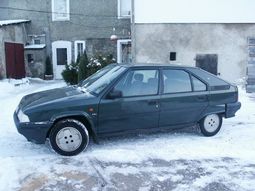
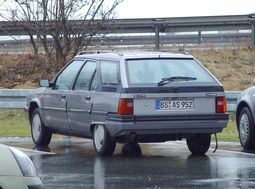
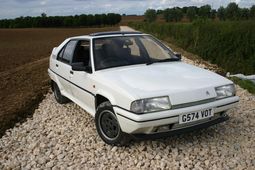
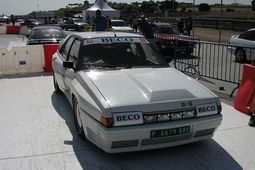
|